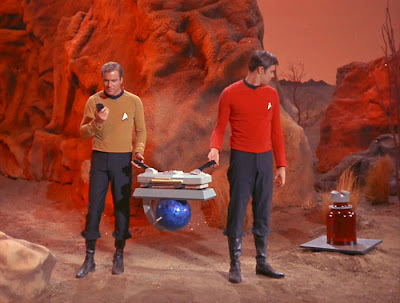"A Piece of the Action"
Story
"The Piece of the Action" is a downright unusual episode of Star Trek. It's another story that utilizes Roddenberry's "parallel Earths" theory, and does so to eliminate the cost of constructing new sets for alien planets and settings. The beautiful thing about "Action" is that the story works because of characterization and plot. One can't help but be drawn into Kirk's plight on Iotia, and though the stakes are very serious, i.e., the possible death of the main cast and the further contamination of an already contaminated society which is extremely violent, the episode never once becomes too serious. There's an energy and a sense of adventure throughout that makes "A Piece of the Action" one of the classic episodes of Star Trek.
Action
It's hard to avoid action when the word's part of the title. We've got Kirk, Spock, and McCoy getting captured, then getting the upper hand, then getting captured again. Fistfights and escapes, machine gun fire, and the stunning of a dozen or so people on the ground from the Enterprise's phasers. Tying it all together is Kirk's rather precarious predicament in trying to reason with an almost completely corrupted society.
Performances
Shanter, Nimoy, and Kelley really shine in "A Piece of the Action," as well as Doohan. You can tell everyone's enjoying the production of this fun episode, which allows the cast to dress in period clothing and interact in a period setting, surely a welcome change of pace from the usual starship and alien environments. Also critical to this episode is Vic Tayback's performance as Joe Krako. Tayback was best known to my generation as the irascible Mel on "Alice."
Trektastic Moments
The entire episode really is a Trektastic moment, in that it removes the crew from their usual setting and brings about truly classic moments. Kirk's attempt at creating "fizzbin," a fictional card game with which he's able to affect an escape, is a joy to watch. There's also wonderful, truly in character banter between Bones and Spock and great reactions from a befuddled Scotty. The best moments here occur when Kirk and Spock are out of their element. Watching Kirk attempt to drive a 1930s era vehicle is hilarious, but not nearly as funny as Spock's reaction to his captain's driving. There's also Kirk's mobster accent and his use of mobster jargon. One has to wonder how he picked all that up so quickly. Spock also has a great moment wherein he slips into the mobster accent for a line. Wonderful stuff all the way through.
Overall
"A Piece of the Action" is a classic episode of Star Trek, filled with the fun, light-hearted spirit of adventure that was so much a part of the original and best Star Trek. Highest possible recommendation.
The episode's title card.

The misunderstood "Mobster Bible" that causes all the ruckus on Iotia...

A Star Trek first: Spock and McCoy actually agree on something. For a second or two.

Kirk and Spock, the original gangsters.
















































